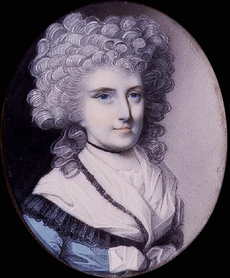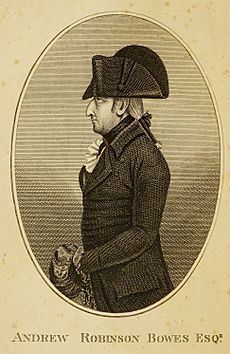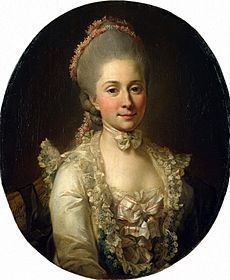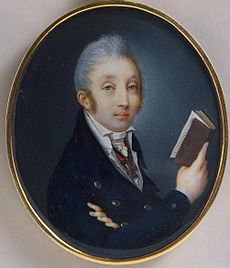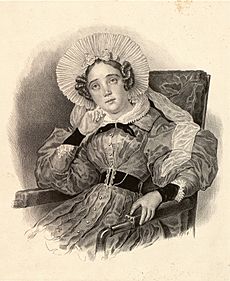Eliza Stephens facts for kids
Eliza Stephens (born Anna Elizabeth Planta; 6 February 1757 – 25 December 1815) was an English governess. A governess was a woman hired to teach and train children in a private home. She worked for a wealthy English noblewoman, Mary Bowes, Countess of Strathmore and Kinghorne. Eliza helped Mary Bowes meet and marry her second husband, Andrew Robinson Stoney.
Eliza married Reverend Henry Stephens, who was a tutor for Mary Bowes's children. After Mary Bowes's marriage, Eliza and Henry received money and a yearly payment. Henry became a curate (a church assistant) in Ponteland. Eliza later helped Stoney keep Mary Bowes's daughter from her mother. This continued until Mary Bowes won a divorce in 1789.
After Henry died around 1790, Eliza's brother, Joseph Planta, helped her find a new job. She became a governess in Russia for Countess Catherine Shuvalova. Countess Shuvalova was a lady-in-waiting to Empress Catherine the Great. Eliza's daughter, Elizabeth, married Mikhail Speransky in 1798. He later became an important advisor to Tsar Alexander I of Russia. Elizabeth died in 1799 after giving birth to her daughter, Elisabeth Bagréeff-Speransky. Eliza Stephens lived with her granddaughter and other family members in Russia until she died in Kyiv in 1815.
Contents
Early Life and Family Background
Anna Elizabeth "Eliza" Planta was born on 6 February 1757. Her father, Andrew Planta, was a pastor in London. He was also an assistant librarian at the British Museum. He became a member of the Royal Society in 1770.
Many of Eliza's sisters also worked as governesses. Her older sister, Elizabeth, taught Mary Eleanor Bowes starting in 1757. Another sister, Frederica, taught the daughters of King George III. Their only brother, Joseph Planta, became the head librarian at the British Museum.
The Planta family spoke many languages. At home, they spoke Romansh. Frederica knew seven languages, including Latin and Greek. Joseph spoke many languages, too. Eliza herself spoke English, French, and Italian very well. They also had musical training. Eliza was known to play the harpsichord.
Working for Mary Eleanor Bowes
Mary Eleanor Bowes was the only child of a rich coal mine owner. She was very well educated and read many books in different languages. In 1757, Eliza's father taught Mary Eleanor French. Eliza's older sister, Elizabeth, was Mary Eleanor's governess.
Mary Eleanor inherited a huge fortune when her father died in 1760. In 1767, she married John Lyon. He took her last name, Bowes. Elizabeth Planta later became a companion to Mary Eleanor's mother. In 1774, Elizabeth returned to work for Mary Eleanor as a governess for her children.
In July 1776, Mary Bowes let Elizabeth Planta go from her service. She gave Elizabeth a large payment of £2,000. Then, Eliza Planta was hired as the new governess for Mary Bowes's children. Eliza quickly became a very important and trusted friend to Mary Bowes.
Marriage to Henry Stephens
In November 1776, Mary Bowes hired Reverend Henry Stephens to tutor her children. He was a widower and had some debts. Eliza and Henry Stephens married very quickly. They ran away together just ten days after they first met. This made Eliza's family very angry. They married in Scotland in late 1776.
Eliza and Henry Stephens had five children. Their names were Jane Elizabeth, Francis William, Henry Planta, Marianne Marg[are]t, and George Andrew Planta. By February 1789, Henry Stephens was working as a curate in Ponteland, Northumberland. Henry Stephens died in 1789 or 1790.
Governess for Russian Nobility
Within six months of Henry's death, Eliza Stephens left for Saint Petersburg, Russia. She went even though she did not have a job offer yet. Her brother Joseph wrote to a friend in Russia, Andrew Samborski. He listed Eliza's skills. She spoke English, French, and Italian fluently. She was also a good singer and played the harpsichord. Joseph thought she would be good for a school for noble girls.
Samborski found Eliza a job with Countess Catherine Shuvalova. The Countess was a powerful person in the Russian royal court. She was a lady-in-waiting to Empress Catherine the Great. Eliza's job was to teach Shuvalova's youngest daughter, Alexandra. After a few months, Shuvalova allowed Eliza to bring her children to Saint Petersburg. Her children Elizabeth, Francis, and Marianne came with their nurse.
Eliza Stephens was known as Elisaveta Andreevna Stephens in Russia. Her family became part of the English-speaking community in Saint Petersburg. In 1792, Stephens traveled with Shuvalova to bring two princesses from Baden to Russia. These princesses were possible brides for the future Tsar Alexander I of Russia.
In 1797, Alexandra married Franz Joseph, Prince of Dietrichstein. Eliza's daughter, Elizabeth, met Mikhail Speransky around this time. Speransky was a civil servant. Elizabeth and Speransky married in late 1798. Soon after, Eliza moved to Vienna with the Dietrichstein family and her children, Francis and Marianne.
In 1799, Eliza's daughter, Elizabeth, gave birth to her only child, Elizaveta Mikhailovna Speranskaya. Sadly, Elizabeth died two months later. Her husband, Speransky, was very sad. He sent his daughter to live with a former nurse. In 1801, Eliza left her job and moved into Speransky's house to care for her granddaughter.
The next year, Eliza's daughter Marianne married Konstantin Zlobin. Eliza's family, including her granddaughter, moved into Konstantin's father's home. Marianne and Konstantin did not get along well. Konstantin was often sad, while Marianne loved to socialize. Konstantin's father suggested the Stephens family take a trip to a spa. When they returned, Konstantin left his wife. The Stephens family lived with Konstantin's father for about two years.
Eliza's granddaughter, Speranskaya, became ill with scarlet fever. Doctors said she needed a warmer climate to recover. Speransky agreed to let her go to Kyiv (now in Ukraine). Konstantin's father bought a house there for Marianne and her family.
Eliza's husband's sister and brother-in-law died in France. Their orphaned children, Melanie and Henri, joined the Speransky family. Henri died in 1811 during a cholera outbreak. Melanie went to Kyiv to join Eliza. There, she met Christian Gottlieb Bunge, a doctor. Melanie and Bunge married in 1806 and had three children.
In 1809, Eliza, Francis, and her grandchildren returned to Saint Petersburg. They moved into Speransky's new house. Days were spent studying, and evenings were full of guests. Marianne divorced Konstantin Zlobin in 1810. She planned to marry another man, Stranek. In 1811, Eliza and Speranskaya visited Marianne. Marianne died at the end of 1811. She left her estate to Speranskaya and her daughter to be cared for by Eliza.
Speransky became a very important advisor to Tsar Alexander I. But in March 1812, he lost the Tsar's favor and was sent away from the capital. He told Speranskaya and Eliza to join him. Francis and Annette went with them. Eliza was upset about the exile. She spread rumors that Annette was Speransky's child, which upset him and Speranskaya.
Later, Speransky was moved further away to Perm. Eliza moved there with the family. Because Speransky was not welcome in Perm, he sent the family back to Saint Petersburg in late 1813. They still visited him. Speranskaya was able to deliver a letter to the Tsar about her father's money problems. The Tsar gave her father a yearly payment. In 1814, Speransky had the family move to an estate called Velikopolye. He joined them later that year. He also returned to government work.
In April 1815, Speransky sent Eliza to Kyiv to live with Melanie Bunge. He was worried Eliza's sadness would affect his daughter. He agreed to pay Eliza a yearly pension of 2,000 to 3,000 rubles. This was a lot of money, about 100 times what a skilled worker earned.
Death and Descendants
Eliza Stephens died on 25 December 1815 in Kyiv. Her niece Melanie died two months later. After Eliza's death, Speransky and Speranskaya continued to care for Francis. He lived with Speransky and his niece, who made sure he was well cared for. Francis died in November 1848.
Russian law made it hard for children born outside of marriage. Speransky made a plan to care for Annette and protect her. In February 1816, he brought her from Kyiv to Velikopolye. He arranged for Annette to go to a boarding school in Saint Petersburg. She studied music and several languages. She was enrolled as Anna Andreevna Smirnovna, a made-up orphan. This was to hide her true background.
In April 1825, Annette married Alexey Osipovich Imberg. Speransky continued to support their family with a yearly allowance. He also helped Imberg get a job.
In 1816, Speranskaya returned to Saint Petersburg. She lived with Maria Weikard, who was like a mother to her. After passing an exam, she started teaching. Three years later, she became a lady-in-waiting to Empress Louise of Baden. In 1822, Speranskaya married Prince Alexander Frolov-Bagreev. They had three children. Her father bought her another estate in Ukraine. She managed her estates until 1850, then moved to Vienna and became a writer. She died in 1857.
Her daughter, Maria Frolova-Bagreeva, married Prince Rodion Nikolaevich Cantacuzène in 1846. They took over managing Speranskaya's estates. Maria's son, Mikhail Rodionovich Cantacuzène, was given his grandfather's title of Count Speransky in 1872. His son, Mikhail, married Julia Dent Grant, who was the granddaughter of U.S. President Ulysses S. Grant.
The estate in Ukraine was destroyed during a war in 1918. The family fled to other countries. The Velikopolye estate was also destroyed during World War II.
Images for kids


